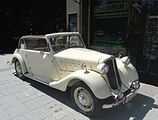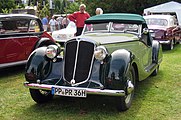Hansa 1100 (1934)
| Hansa | |
|---|---|
|
Hansa 1100 sedan (1937)
|
|
| 1100/1700 | |
| Production period: | 1934-1939 |
| Class : | Middle class |
| Body versions : | Limousine , convertible sedan , cabriolet , roadster |
| Engines: |
Petrol engines : 1.1–1.7 liters (20–29 kW) |
| Length: | 4100-4270 mm |
| Width: | 1525 mm |
| Height: | 1470 mm |
| Wheelbase : | 2700-2870 mm |
| Empty weight : | 1020-1080 kg |
The Hansa 1100 is a mid -range vehicle from the Hansa-Lloyd and Goliath works in Borgward & Tecklenborg in Bremen-Hastedt . At the same time, the more powerfully motorized model Hansa 1700 was brought out.
history
The prototypes were presented at the Berlin Motor Show in March 1934. Series production began that same year.
In 1939, according to other sources as early as 1938, production had to be stopped because the Schell Plan only allowed the company to manufacture a heavy type of car with a displacement between 2.0 and 3.0 liters.
Engine, transmission and chassis
The four-cylinder in-line engine of the Hansa 1100 had an output of 20 kW (27.5 hp) at 3600 rpm. With a bore of 65 mm and a stroke of 82 mm, the displacement was 1088 cm³. The compression ratio is given as 5.8: 1. The hanging valves were operated by a side camshaft via bumpers and rocker arms ( OHV valve control ), which in turn was driven by spur gears . The mixture was prepared by a single carburetor of the type Solex 26 BFLH .
The six-cylinder in-line engine of the Hansa 1700 had a displacement of 1634 cm³ and developed 29 kW (40 hp) at 3800 rpm. Bore, stroke and compression correspond to those of the four-cylinder model. A Solex 30 BFLH was used as the carburetor .
The top speed of all body variants of the Hansa 1100 was 90 km / h, the four-seater models of the Hansa 1700 drove up to 100 km / h, the two-seater sports models up to 103 km / h.
All cars were equipped with a four-speed gearbox, the gear lever of which was in the middle of the car (stick shift). None of the speed steps was synchronized. The rear wheels were driven.
The superstructures rested on a central box frame that was forked at the front and rear. The front wheels were suspended from two transverse leaf springs, the rear pendulum swing axle from one. All 4 wheels were braked hydraulically; the handbrake worked on the rear wheels. The cars were equipped with grease nipples .
The fuel consumption of the Hansa 1100 was 9.5 liters / 100 km, that of the Hansa 1700 was 11.5 liters / 100 km.
Bodies
Both types were available as 2-door sedans , 2-door convertible sedans and 2-door, 4-seat convertibles ; the doors were hung at the back. From 1935 there was a sports convertible with 2 seats from the Hansa 1700, from 1936 also the Hansa 1100. In 1936 and 1937 only the Hansa 1700 was also available as a 2-seater roadster . The streamlined bodies had a backward sloping grille between the individual headlights. The fenders were pulled back with a swing; the front ended at the A-pillars , the rear in a flat tail.
Gallery images
Individual evidence
- ↑ a b c d e f g h i j k l m Werner Oswald: Deutsche Autos 1920–1945 . Motorbuch Verlag, Stuttgart 1996. 10th edition. ISBN 3-87943-519-7 . P. 153.
- ↑ a b Werner Oswald: German Cars 1920–1945 . Motorbuch Verlag, Stuttgart 1996. 10th edition. ISBN 3-87943-519-7 . P. 150.
- ^ A b Georg Schmidt: Borgward - Carl FW Borgward and his cars . Motorbuch Verlag, Stuttgart 1982. 3rd edition. ISBN 3-87943-679-7 . P. 224.
- ↑ Werner Oswald: German Cars 1920–1945 . Motorbuch Verlag, Stuttgart 1996. 10th edition. ISBN 3-87943-519-7 . Pp. 150, 153.
- ^ Georg Schmidt: Borgward - Carl FW Borgward and his cars . Motorbuch Verlag, Stuttgart 1982. 3rd edition. ISBN 3-87943-679-7 . P. 82.







